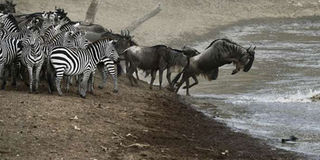Involve communities to reduce conflicts

Wildebeests and zebras prepare to cross a river in Masai Mara on September 2, 2015. The Mara is simply amazing. PHOTO | NATION MEDIA GROUP
What you need to know:
- As the number of people around the Mara grows, together with the number of livestock, grazing land has shrunk, creating an economic and political problem.
- The stakeholders have set up trusts to raise funds to assist the local communities in the areas of health, education, and commercial activities such as bead-making and marketing.
Maasai Mara Game Reserve has in the past been touted as the eighth wonder of the world.
Probably nowhere else in the world can one see the large variety of animals that roam its wide expanse of land and ecosystem. It is also home to the annual wildebeest migration. The Mara is simply amazing.
In recent times, however, the conversation has turned from the wonders of the Mara to the dangers that threaten this great international treasure that is a big tourist attraction in Kenya.
One key threat is the age-old human-wildlife conflict. As the number of people around the Mara grows, together with the number of livestock, grazing land has shrunk, creating an economic and political problem.
Second is the built-up areas. In some parts of Maasai Mara, there are so many camps and hotels that they threaten to turn the reserve into one big slum, a prospect that would not be attractive to both the animals and the tourists.
It is worrying that if nothing is done to stop this, the animals will eventually move south to Serengeti in Tanzania, where there is more space for them.
This is where the conservancies come in. The ones in the Mara teach important lessons on how business and community interests can exist side by side while focusing on conserving both the environment and natural resources.
The Maasai Mara group brings together the owners of 16 conservancies covering more than 400,000 acres and more than 20,000 Maasai families that have agreed to put their land together for conservation.
They team up with the owners of camps in the conservancies. The agreement is that the landowner gets paid a certain amount for every bed night in the camps.
In exchange, the landowner agrees to limit the number of animals he keeps and the frequency of their grazing to ensure that the balance between livestock and wildlife is maintained.
Both parties agree not to fence their land so that wildlife can move freely across the conservancies, which are managed by a board of representatives of the land and camp owners.
The board ensures that rules such as the one that says that there can only be one camp for every 350 acres are enforced.
INTERRUPTED GROWTH
The stakeholders have set up trusts to raise funds to assist the local communities in the areas of health, education, and commercial activities such as bead-making and marketing.
The Maa Trust is particularly active in this area. Due to these efforts, an abattoir has been set up to buy cattle from the Maasai and market the meat in Nairobi and other parts of the country.
This not only assures the community of a market but also fetches better prices than what middlemen offer. The surrounding families are the first choice in case of employment opportunities in conservancies.
The model of the Maasai Mara conservancies could offer solutions to the perennial conflicts that assail African countries that have natural resources, whose genesis is usually the exclusion of the local communities.
Examples abound — diamonds in Angola, oil in Nigeria, and gold and diamonds in the Democratic Republic of the Congo. The conflicts have retarded developed in these countries.
Is the Maasai Mara arrangement perfect? Far from it, and it gets severely tested in lean tourist times such as the current one.
However, stakeholders can still cooperate and agree on what needs to be done for the good of all those concerned, including the animals — both wild and domestic.
Perhaps the government can borrow this model for the areas where oil has recently been discovered. This could take care of the noises that have already started coming from the concerned communities and nip in the bud potential discontent and conflict.
Mr Gitahi is the chairman of Maasai Mara Wildlife Conservancies Association. [email protected].




